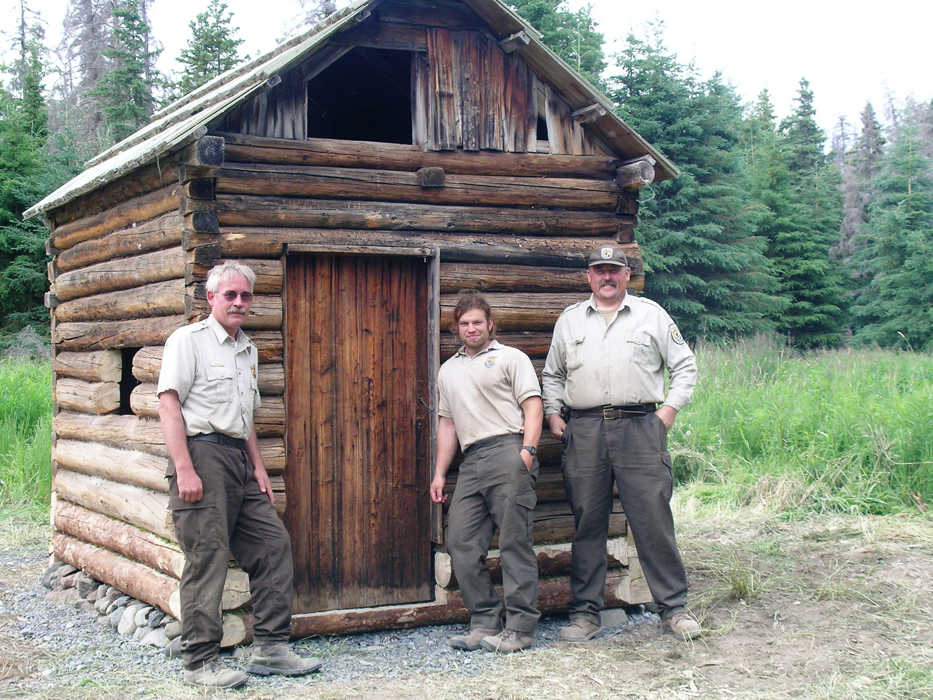Have you ever stayed at a Kenai National Wildlife Refuge cabin enjoying the beauty and peace of nature? Or browsed the historic Elwell and Andrew Berg Cabins at the Refuge Visitor Center Complex? Do you ever wonder how these cabins came to be?
Well, these recreation and historical education cabins are the visionary legacy of Park Ranger Gary Titus, who retires on Dec. 31 after 15 years of service to Kenai Refuge. Since 2000, Gary has spearheaded a comprehensive program to restore, preserve, and interpret Refuge historic cabins. The Refuge Cabin Management Program that Gary has developed maintains 24 cabins, of which 16 are available for overnight stays by locals and visitors alike, and the remaining are preserved for historical interpretation purposes and can be visited for viewing.
Fourteen of the 16 cabins can be conveniently reserved online at www.recreation.gov — the other two are available on a “first come, first served” basis. Fees generated from cabin reservations go directly back into maintaining and improving the cabins. Over the years, Gary has supervised cabin crews, Youth Conservation Corps (YCC), Kenaitze youth, and community volunteers in the careful restoration of Refuge historic cabins and, also, in the construction of new log cabins for public use.
Prior to Gary’s arrival at the Refuge in 2000, the historic cabins were in a highly degraded state and suffered a high incidence of vandalism. Through Gary’s efforts, the Refuge has noted a growing stewardship ethic by local residents and visitors for these important cultural resources. We have Gary to thank for this “sea change” through his dedication and tireless efforts to create and maintain a first-rate Cabin Management Program at Kenai Refuge.
Gary has reached beyond the Refuge to assist in local community historical preservation projects at the Kasilof Historical Society and with the Kenaitze Tribe at the K’Beq interpretive site near the Russian River. His expertise is in great demand and he has been recruited to lead teams in historic structure restoration for the Alaska Department of Natural Resources, U. S. Forest Service, Bureau of Land Management, and National Wildlife Refuges in the Lower 48.
Gary was instrumental in creating a training course, “Stabilization and Preservation Techniques for Historic Log Structures” to help train others in accomplishing restoration work. Using historically appropriate hand tools and techniques, Gary demonstrated and taught his students a high degree of technical expertise in restoration work. The end goal is that their projects will exactingly restore historical structures to the original way their builders made them — right down to axe marks on the replacement logs.
Gary not only is a “hands on” project guy, he is also a dedicated researcher and writer. Gary has registered over 100 historic cabin and cabin sites with the State of Alaska’s Office of History and Archeology. Two cabins are now listed in the National Registry of Historic Places thanks to Gary’s efforts. He has catalogued almost 500 historic artifacts ranging from miner’s tools to antlers from our endemic (and now extinct) woodland caribou to a Kenaitze skin scraper found on Caribou Island. He has also catalogued more than 10,000 historic photos of the Kenai Refuge and Peninsula.
He has a passion for the history of the Big Game Guide Era in Alaska circa 1880-1940. Gary wrote and published a book with Catherine Cassidy entitled “Alaska’s No. 1 Guide: The History and Journals of Andrew Berg, 1869 – 1939”. He has other writing projects in the works that will keep him busy in retirement and that we can look forward to reading in the future.
And if that’s not enough, Gary was a commissioned Federal law enforcement officer for the first 12 years of his tenure with the U.S. Fish and Wildlife Service.
Ranger Gary Titus was honored for his work in 2013 as the winner of the Alaska Region’s U. S. Fish and Wildlife Service’s Sense of Wonder Award. Gary was recognized for his outstanding achievement in the field of historical interpretation and preservation. The award recognized Gary’s ability to foster a sense of wonder and stewardship for the historic heritage of Kenai National Wildlife Refuge.
Gary looks forward to a rewarding retirement at his remote cabin in the Twin Lakes country across Cook Inlet where he enjoys wildlife observation, fishing, hunting, and exploring the outdoors by foot, ski and boat. Gary not only will find life better at his cabin retreat, but can retire with the thanks of countless people who have felt the same way during their cabin stays on Kenai Refuge. “Life is truly better at the cabin.”
Park Ranger Candace Ward has managed the Information & Education Program at Kenai National Wildlife Refuge for over 30 years. She is honored to be Gary Titus’ colleague for the last 15 years. Find more information atwww.fws.gov/refuge/kenai/ or www.facebook.com/kenainationalwildliferefuge.

